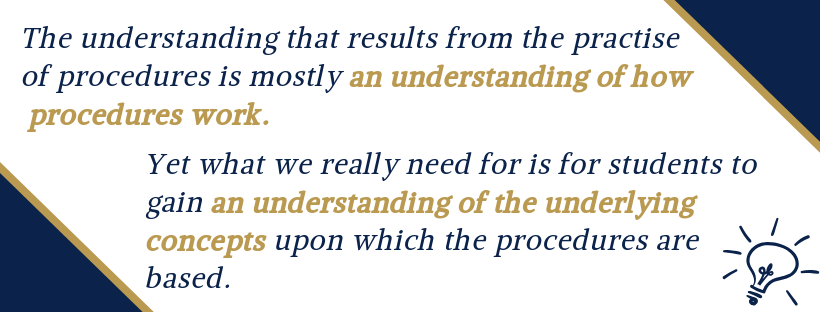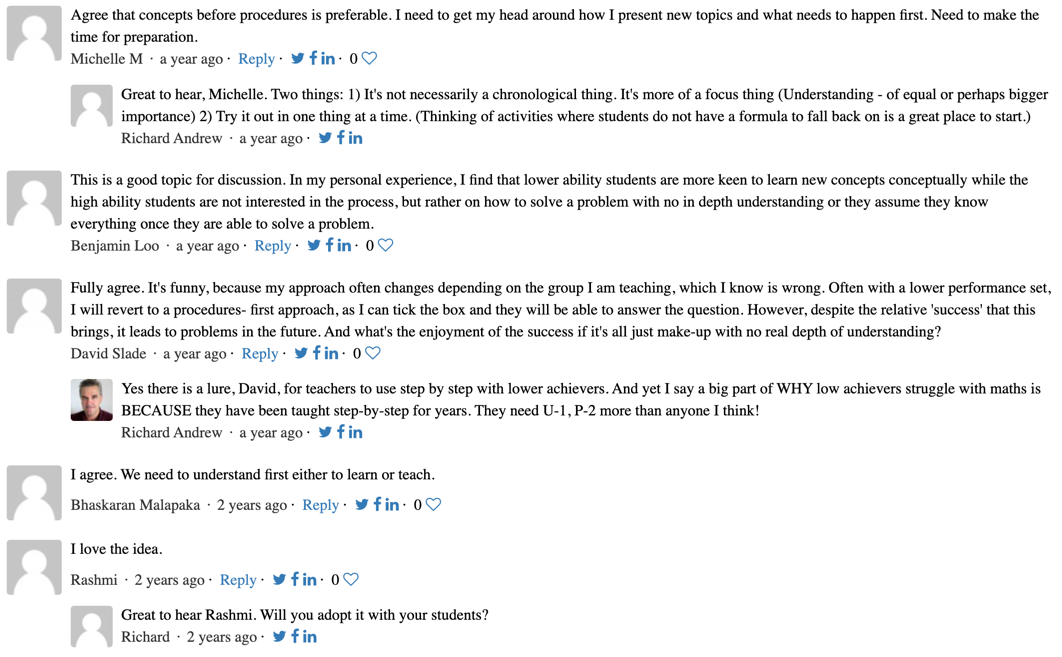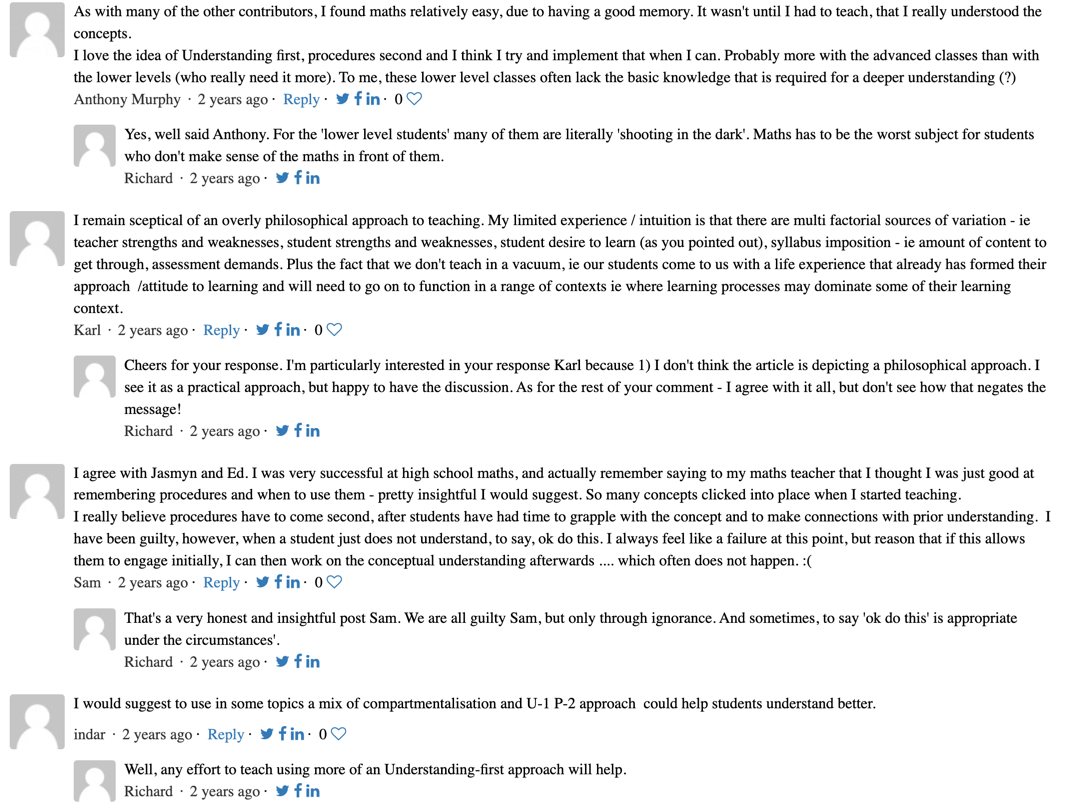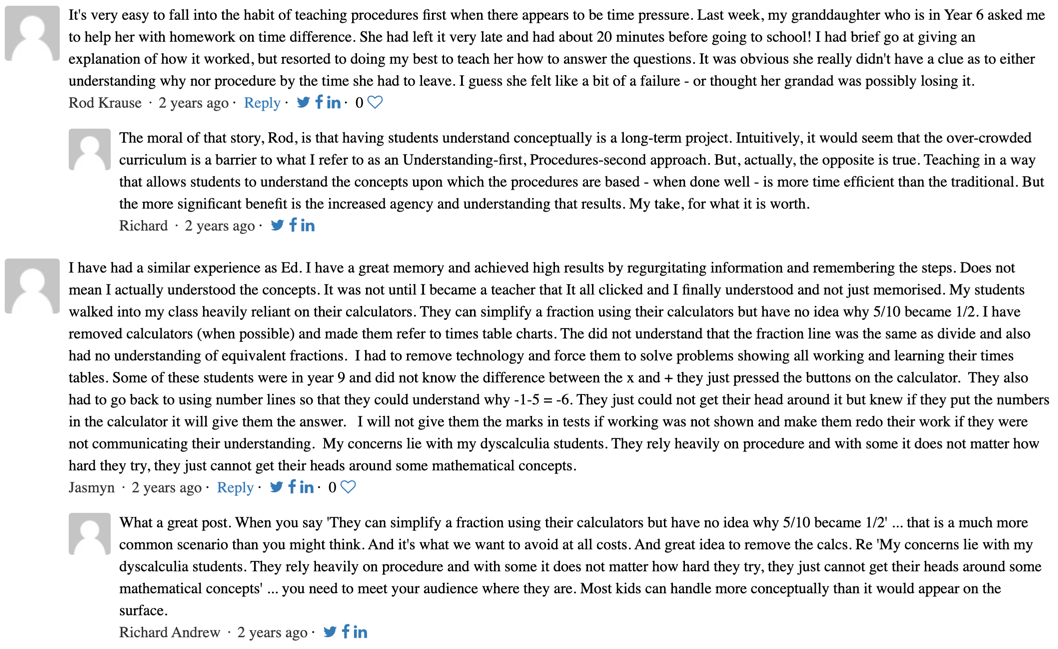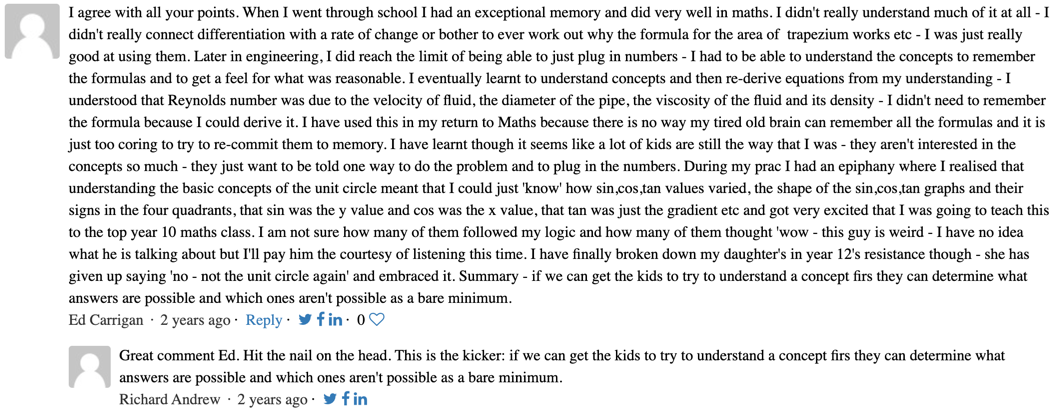Why We Need An
Understanding-first, Procedures-second Mindset
When Teaching Mathematics
Rewritten 22.10.21
Most teachers agree that procedural knowledge is essential if students are to be successful in mathematics. However, this article will explain why there is a problem with an over-emphasis on procedural teaching.
The conventional Procedures-first mindset explained.
In my early years of teaching, I was a Procedures-first teacher. Allow me to explain …
As a Procedures-first teacher, I would walk into a classroom having, as my top priority, to teach the next series of procedures of the current unit of work and to have students gain sufficient practice with those procedures. Of course, I occasionally threw in some alternative activities and investigations. However, my default and #1 priority was to teach procedures. In fact, I didn’t even consider this to be a priority because teaching procedures was what I assumed mathematics teaching was. I have reason to believe that, although nobody teaches ONLY via procedures, the ‘Procedures-first’ approach remains the dominant approach used in maths classrooms today. |
What about understanding?
As a Procedures-first teacher, my view was that students gained mathematical understanding through the practice of procedures. Provided students answered enough questions based on a specific routine or procedure, they would acquire the necessary mathematical understanding.
This was the view preached to me when I was a student, and it was certainly the mantra I preached to my students when I began teaching.
This was the view preached to me when I was a student, and it was certainly the mantra I preached to my students when I began teaching.
But as a Procedures-first teacher, I knew that for many students, real understanding never came - for many students, the understanding acquired was little more than a vague idea of what procedure to use in which situation.
The 'real understanding' I refer to above occurs when students understand the concept upon which a given procedure or routine is based.
This is why we could refer to the approach (or mindset) as Procedures-first, Understanding-second; i.e the emphasis is on teaching procedures in the HOPE that understanding will follow. Mathematical understanding is not the primary focus, rather, the primary focus is the teaching of procedures.
The 'real understanding' I refer to above occurs when students understand the concept upon which a given procedure or routine is based.
This is why we could refer to the approach (or mindset) as Procedures-first, Understanding-second; i.e the emphasis is on teaching procedures in the HOPE that understanding will follow. Mathematical understanding is not the primary focus, rather, the primary focus is the teaching of procedures.
The Procedures-first approach (or mindset) has, by default, a major flaw.
Note that I am not criticising teachers. We all do our best with what we know. But the fact is, we only know what we know, and we don’t know what we don’t know. And one thing that the many exceptional proceduralists seem to be unaware of is that a Procedures-first approach has a major flaw.
Too many students spend too much time in too many lessons not understanding the mathematics!
If we enter mathematics lessons with a Procedures-first mindset; then, by default, we significantly reduce the chance of students understanding the concept upon which any given procedure is based.
Suppose this manifests across many routines and procedures. Then, we end up with - potentially - many students NOT understanding the maths tasks they are working on for a great deal of time in a great number of lessons. These students are then unable to make the connections between procedures due to their lack of conceptual understanding. School mathematics becomes, for many of these students, little more than a nightmarish waste of time.
Suppose this manifests across many routines and procedures. Then, we end up with - potentially - many students NOT understanding the maths tasks they are working on for a great deal of time in a great number of lessons. These students are then unable to make the connections between procedures due to their lack of conceptual understanding. School mathematics becomes, for many of these students, little more than a nightmarish waste of time.
The learning of routines and procedures is important
The teaching of procedures should still be a priority. However, I suggest that having students understand the concept upon which a given procedure is based is the highest priority, followed by the learning of procedures.
Why students need to understand related maths concepts before learning procedures
The Committee on Developments in the Science of Learning, (2000, p. 8) cited 'learning with understanding (as) one of the hallmarks of the new science of learning'. In other words, understanding needs to be present for learning to occur.
That understanding needs to be present for learning to occur is so obvious I have no idea why it needs to be researched. (When was the last time you successfully learned something complicated that you had no understanding about?) But, there you have it - the claim has been backed up by research - understanding needs to be present for learning to occur!
That understanding needs to be present for learning to occur is so obvious I have no idea why it needs to be researched. (When was the last time you successfully learned something complicated that you had no understanding about?) But, there you have it - the claim has been backed up by research - understanding needs to be present for learning to occur!
Resilience
I can hear the objections … but Richard, students NEED to grapple with concepts before truly understanding them. To believe that students are going to understand a concept the first time every time is ridiculous!
I agree that grappling with mathematics builds resilience. However, we all know that when students do not understand the mathematics they are working on for extended periods of time, they begin to dislike - even hate - mathematics; they switch off, and the door to meaningful learning shuts.
Also - and this is my key point - there is a massive difference between students grappling with some mathematics (with a level of confidence that they will eventually understand it) and students who have little clue about most of the mathematics tasks we give them to do.
In conclusion, I’m proposing that the Procedures-first, Understanding-second mindset results in too many students spending an unnecessary amount of time not understanding the activities they are tasked to work through. And this leads to disengagement, which, in turn, blocks them from learning and forms the mindset ‘I'm a failure at mathematics’.
The follow-up question to ask, then, is this:
How can we have more students having more understanding of what they are working on for more time in more lessons?
I agree that grappling with mathematics builds resilience. However, we all know that when students do not understand the mathematics they are working on for extended periods of time, they begin to dislike - even hate - mathematics; they switch off, and the door to meaningful learning shuts.
Also - and this is my key point - there is a massive difference between students grappling with some mathematics (with a level of confidence that they will eventually understand it) and students who have little clue about most of the mathematics tasks we give them to do.
In conclusion, I’m proposing that the Procedures-first, Understanding-second mindset results in too many students spending an unnecessary amount of time not understanding the activities they are tasked to work through. And this leads to disengagement, which, in turn, blocks them from learning and forms the mindset ‘I'm a failure at mathematics’.
The follow-up question to ask, then, is this:
How can we have more students having more understanding of what they are working on for more time in more lessons?
The Understanding-first, Procedures-second mindset
Rather than operating with a Procedures-first mindset, why not prepare students for the coming procedures by presenting them with well-structured exploratory activities that foster understanding of the very concepts upon which the forthcoming procedures are based?
Teachers who walk into their mathematics classrooms with an Understanding-first, Procedures-second mindset realise the importance of procedures and procedural knowledge. However, they realise that having students understand what they are working on for the majority of lesson time is the key aim. And they realise that to reach that aim they need to enable their students to understand the concepts upon which the routines and procedures are based.
Teachers who walk into their mathematics classrooms with an Understanding-first, Procedures-second mindset realise the importance of procedures and procedural knowledge. However, they realise that having students understand what they are working on for the majority of lesson time is the key aim. And they realise that to reach that aim they need to enable their students to understand the concepts upon which the routines and procedures are based.
Some principles of an Understanding-first, Procedures-second mindset/approach:
The following bullets are common to any Understanding-first approach. More could be added.
If you are thinking ‘Well, Richard, this sounds fine in theory, BUT in practice, I can't see it working … ' then check out the article ‘The Understanding-first, Procedures-second Approach in Action - Three Examples’.
- Use activities that require students to use their own thinking to explore the concepts that underpin the soon-to-be-taught procedures.
- (Therefore) use well-structured activities that have a degree of open-endedness and student-centeredness.
- Where possible and when appropriate, have students collaboratively determine the associated procedures and workshop these discoveries as a class.
- Generally, strive to allow students to understand the mathematics they are working on for the majority of lesson time.
If you are thinking ‘Well, Richard, this sounds fine in theory, BUT in practice, I can't see it working … ' then check out the article ‘The Understanding-first, Procedures-second Approach in Action - Three Examples’.
Related Articles
Why Students Need To Understand The Concept Before We Teach Them The Procedure - here
Let's stop forcing our mathematics students to play the memory game! - here
Too Many Kids Hate Maths - here
The Understanding-first, Procedures-second Approach In Action - here
Why Compartmentalising Is A Bad Idea When Teaching Mathematics - here
Could These Four Aspects Of Mathematical Understanding Change The Way We Teach Maths? - here
70% Of Capable Students Are Failing Mathematics. What Can We do? - here
Call to Action
I'd love to hear your thoughts. What points do you agree with? What do you disagree with? Do share!
NOTE: Create a Hyvor account before commenting (click LOGIN) -that way you'll be notified of replies and you won't be anonymous.
If you don't create an account, please state your name at the start of your comment. Thanks.
NOTE: Create a Hyvor account before commenting (click LOGIN) -that way you'll be notified of replies and you won't be anonymous.
If you don't create an account, please state your name at the start of your comment. Thanks.
Some Past Comments



